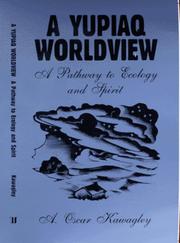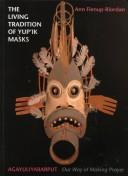| Listing 1 - 10 of 21 | << page >> |
Sort by
|

ISBN: 0881338591 Year: 1995 Publisher: Waveland
Abstract | Keywords | Export | Availability | Bookmark
 Loading...
Loading...Choose an application
- Reference Manager
- EndNote
- RefWorks (Direct export to RefWorks)
Science --- Yupik Eskimos --- Yupik Eskimos --- Study and teaching --- Education --- Science

ISBN: 0295975237 Year: 1996 Publisher: Seattle (Wash.) : University of Washington press,
Abstract | Keywords | Export | Availability | Bookmark
 Loading...
Loading...Choose an application
- Reference Manager
- EndNote
- RefWorks (Direct export to RefWorks)
Yupik Eskimos --- Yupik art --- Yupik masks --- Religion --- Exhibitions. --- Exhibitions. --- Exhibitions.
Book
Year: 2014 Publisher: Anchorage, Alaska : National Park Service, Shared Beringian Heritage Program,
Abstract | Keywords | Export | Availability | Bookmark
 Loading...
Loading...Choose an application
- Reference Manager
- EndNote
- RefWorks (Direct export to RefWorks)
Plants, Edible --- Yuit Eskimos --- Yupik Eskimos --- Ethnobotany --- Food
Book
Year: 1979 Publisher: Ottawa : National Museums of Canada,
Abstract | Keywords | Export | Availability | Bookmark
 Loading...
Loading...Choose an application
- Reference Manager
- EndNote
- RefWorks (Direct export to RefWorks)
Eskimos --- Canoes and canoeing --- Eskimos --- Kayaks --- Yupik Eskimos --- Boats --- Hunting --- Boats.
Book
Year: 2011 Publisher: Washington, D.C. : Smithsonian Institution Scholarly Press : Arctic Studies Center,
Abstract | Keywords | Export | Availability | Bookmark
 Loading...
Loading...Choose an application
- Reference Manager
- EndNote
- RefWorks (Direct export to RefWorks)
Yupik Eskimos --- Photograph collections --- Waugh, Leuman M. --- National Museum of the American Indian (U.S.)
Book
ISBN: 1501701401 150170141X Year: 2010 Publisher: Ithaca, New York : Cornell University Press,
Abstract | Keywords | Export | Availability | Bookmark
 Loading...
Loading...Choose an application
- Reference Manager
- EndNote
- RefWorks (Direct export to RefWorks)
From the 1780's to the 1820's, Kodiak Island, the first capital of Imperial Russia's only overseas colony, was inhabited by indigenous Alutiiq people and colonized by Russians. Together, they established an ethnically mixed "kreol" community. Against the backdrop of the fur trade, the missionary work of the Russian Orthodox Church, and competition among Pacific colonial powers, Gwenn A. Miller brings to light the social, political, and economic patterns of life in the settlement, making clear that Russia's modest colonial effort off the Alaskan coast fully depended on the assistance of Alutiiq people. In this context, Miller argues, the relationships that developed between Alutiiq women and Russian men were critical keys to the initial success of Russia's North Pacific venture. Although Russia's Alaskan enterprise began some two centuries after other European powers-Spain, England, Holland, and France-started to colonize North America, many aspects of the contacts between Russians and Alutiiq people mirror earlier colonial episodes: adaptation to alien environments, the "discovery" and exploitation of natural resources, complicated relations between indigenous peoples and colonizing Europeans, attempts by an imperial state to moderate those relations, and a web of Christianizing practices. Russia's Pacific colony, however, was founded on the cusp of modernity at the intersection of earlier New World forms of colonization and the bureaucratic age of high empire. Miller's attention to the coexisting intimacy and violence of human connections on Kodiak offers new insights into the nature of colonialism in a little-known American outpost of European imperial power.
Russians --- Pacific Gulf Yupik Eskimos --- Acculturation --- History. --- Kodiak Island (Alaska) --- Alaska --- History
Book
ISBN: 1602231532 9781602231535 9781602230491 1602230498 Year: 2009 Publisher: Fairbanks University of Alaska Press
Abstract | Keywords | Export | Availability | Bookmark
 Loading...
Loading...Choose an application
- Reference Manager
- EndNote
- RefWorks (Direct export to RefWorks)
Masks are an ancient tradition of the Alutiiq people on the southern coast of Alaska. Alutiiq artists carved the masks from wood or bark into images of ancestors, animal spirits, and other mythological forces; these extraordinary creations have been an essential tool for communicating with the spirit world and have played an important role in dances and hunting festivities for centuries. Giinaquq: Like a Face presents thirty-three full-color images of these fantastic and eye-catching masks, which have been preserved for more than a century as part of the Pinart Collection in a small French museum. These masks, collected in 1871 by a young French scholar of indigenous cultures, are presented for the first time in their complete cultural context, celebrating the rich history of the Alutiiq people and their artistic traditions.
Pacific Gulf Yupik Eskimos --- Eskimo masks --- Material culture --- Kodiak Island (Alaska) --- Social life and customs

ISBN: 0295975016 9780295975016 Year: 1996 Publisher: Seattle, Wash. University of Washington Press
Abstract | Keywords | Export | Availability | Bookmark
 Loading...
Loading...Choose an application
- Reference Manager
- EndNote
- RefWorks (Direct export to RefWorks)
Ethnology. Cultural anthropology --- Yup'ik --- masks [costume] --- Alaska --- Masques yupik --- Yupik (Inuits) --- Yupik masks --- Yupik art --- Yupik Eskimos --- Religion --- Exhibitions. --- Antiquities --- Masques yupik. --- Religion. --- Alaska [state]
Book
ISBN: 1602232172 9781602232174 9781602232167 1602232164 Year: 2013 Publisher: Fairbanks
Abstract | Keywords | Export | Availability | Bookmark
 Loading...
Loading...Choose an application
- Reference Manager
- EndNote
- RefWorks (Direct export to RefWorks)
The Siberian Yupik people have endured centuries of change and repression, starting with the Russian Cossacks in 1648 and extending into recent years. The twentieth century brought especially formidable challenges, including forced relocation by Russian authorities and a Cold War "ice curtain" that cut off the Yupik people on the mainland region of Chukotka from those on St. Lawrence Island. Yet throughout all this, the Yupik have managed to maintain their culture and identity. Igor Krupnik and Michael Chlenov spent more than thirty years studying this resilience through original fieldwor.
Yupik Eskimos --- Kuskokwagmiut Eskimos --- Kuskokwim Eskimos --- Yulugpiaq Eskimos --- Yupiak Eskimos --- Yupiaq Eskimos --- Yupiat Eskimos --- Yu'ik Eskimos --- Eskimos --- History --- Social conditions. --- Social life and customs. --- Pacific Ocean
Book
Year: 2003 Publisher: Anchorage, Alaska : [National Park Service, Alaska System Support Office?],
Abstract | Keywords | Export | Availability | Bookmark
 Loading...
Loading...Choose an application
- Reference Manager
- EndNote
- RefWorks (Direct export to RefWorks)
| Listing 1 - 10 of 21 | << page >> |
Sort by
|

 Search
Search Feedback
Feedback About UniCat
About UniCat  Help
Help News
News